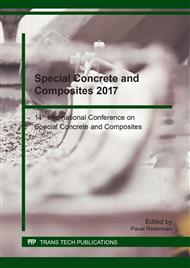p.37
p.43
p.49
p.55
p.61
p.67
p.73
p.83
p.91
Influence of Ambient Temperature on Course of Cement Stone Solidification
Abstract:
The aim of the work was to investigate the influence of extremely low and high temperature on the course of hydration of cement stone compared to the reference sample hydrated at normal conditions. The work was structured in such a way that Portland cement was first subjected to standard technological tests. Next, sets of test prisms using cement paste were prepared. This samples were immediately exposed to saturated water vapor in three temperature environments: 5 °C, 20 °C and 80 °C. The course of the hydration process during the first 28 days was monitored by the determination of the phase composition by XRD analysis and thermal analysis, and mediated by means of determination of tensile strength after bending and compressive strength. The low temperature did not have a negative effect on the final properties of the hardened cement stone. On the other hand, high temperature accelerated the initial phase of the hydration process, but negatively affected the resulting mechanical parameters
Info:
Periodical:
Pages:
61-66
Citation:
Online since:
January 2018
Authors:
Price:
Сopyright:
© 2018 Trans Tech Publications Ltd. All Rights Reserved
Share:
Citation:


